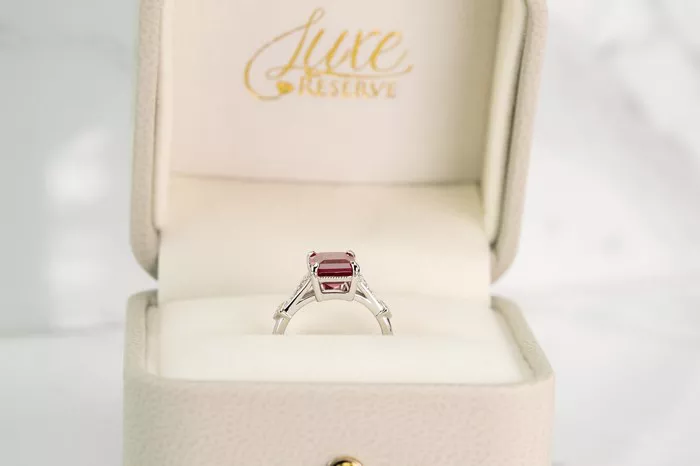Historical Context
Engagement rings, steeped in tradition and symbolism, have a rich history dating back to ancient civilizations. The practice of giving a ring as a token of betrothal can be traced back to ancient Egypt, where rings made of braided reeds were exchanged as a symbol of eternal love. The ancient Romans adopted this tradition, using rings made of durable materials like iron to signify strength and permanence in their unions.
However, it wasn’t until the late 15th century that diamonds entered the scene as a symbol of engagement. The first recorded instance of a diamond engagement ring dates back to 1477 when Archduke Maximilian of Austria proposed to Mary of Burgundy with a ring featuring a delicate diamond set in the shape of an “M.” This royal gesture sparked a trend among European nobility, and diamond rings became synonymous with betrothal among the elite.
Cultural Shifts
The popularity of diamond engagement rings experienced a significant surge in the late 19th century, driven by cultural and social factors. The discovery of diamond mines in South Africa in 1867 flooded the market with these precious stones, making them more accessible to a broader range of people. This newfound abundance of diamonds coincided with the rise of the middle class and changing attitudes towards marriage and romance.
As societal norms evolved, romantic love began to take precedence over arranged marriages, and couples sought tangible symbols of their commitment. Diamond engagement rings, with their association with wealth, status, and eternal love, became the ultimate expression of romantic devotion. The trend gained further momentum with the endorsement of celebrities and social influencers, who popularized the idea of a diamond ring as an essential component of a successful proposal.
Economic Impact
The increased supply of diamonds from South Africa had a profound impact on the diamond market. Previously considered rare and exclusive, diamonds became more affordable, allowing jewellers to cater to a broader consumer base. This democratization of diamonds transformed them from mere luxury items into symbols of aspiration and social status.
Additionally, advancements in diamond cutting and polishing techniques enhanced the brilliance and fire of these gemstones, further fueling their desirability. As a result, diamond engagement rings became increasingly ingrained in popular culture, symbolizing not only love and commitment but also prosperity and success.
Marketing Influence
Perhaps the most significant turning point in the history of diamond engagement rings was the launch of De Beers’ iconic advertising campaign, “A Diamond is Forever,” in 1947. Conceived by advertising agency N.W. Ayer, this campaign aimed to position diamonds as timeless symbols of enduring love and commitment.
Through strategic marketing tactics, De Beers successfully linked the idea of eternal love with the eternal durability of diamonds. The campaign appealed to consumers’ emotions, emphasizing the sentimental value of diamonds as heirlooms passed down through generations. As a result, the demand for diamond engagement rings soared, cementing their status as the ultimate symbol of romantic devotion.
Modern Trends
In contemporary society, diamond engagement rings continue to reign supreme as the preferred choice for couples embarking on the journey of marriage. While trends may ebb and flow, diamonds remain timeless and classic, transcending fleeting fashion fads. Influenced by celebrities and social media influencers, modern couples often opt for unique designs and customizations to reflect their personal style and love story.
From traditional solitaire settings to elaborate halo designs and vintage-inspired settings, the options for diamond engagement rings are endless. Additionally, ethical considerations have become increasingly important, with many couples opting for ethically sourced diamonds or alternative gemstones to align with their values.
Symbolism and Significance
The symbolism of diamond engagement rings extends far beyond their sparkling facade. Diamonds are renowned for their durability and resilience, mirroring the qualities necessary for a successful marriage. As symbols of purity and perfection, diamonds represent the unbreakable bond between two individuals embarking on a lifelong journey together.
Furthermore, the act of presenting a diamond ring signifies the commitment to cherish and protect the love shared between partners. In a world where relationships are constantly tested, diamond engagement rings serve as tangible reminders of the promises made and the vows exchanged.
Consumer Advice
For those embarking on the journey of selecting the perfect diamond engagement ring, several factors should be considered to ensure a meaningful and memorable purchase.
First and foremost, familiarize yourself with the 4Cs of diamond quality: Cut, Color, Clarity, and Carat weight. The cut of a diamond determines its brilliance and sparkle, while color and clarity affect its overall appearance and value. Carat weight refers to the size of the diamond and is often a matter of personal preference and budget.
When choosing a diamond ring, it’s essential to establish a realistic budget and prioritize factors based on your preferences and priorities. Whether you prefer a classic round diamond or a fancy-shaped stone, consider how the ring reflects your personal style and relationship dynamics.
Additionally, don’t overlook the importance of ethical sourcing and sustainability. Opt for reputable jewellers who offer ethically sourced diamonds and transparent supply chains to ensure your purchase aligns with your values.
Ultimately, the perfect diamond engagement ring is one that encapsulates the unique love story shared between you and your partner, serving as a timeless symbol of your commitment to one another.
In conclusion, the evolution of diamond engagement rings from ancient roots to modern symbolism is a testament to their enduring allure and significance in romantic rituals. As cultural norms shift and societal values evolve, the timeless beauty of diamonds remains a steadfast symbol of eternal love and devotion. By understanding the historical context, cultural shifts, economic impact, marketing influence, and modern trends surrounding diamond engagement rings, couples can make informed decisions that reflect their values, preferences, and commitment to one another.

